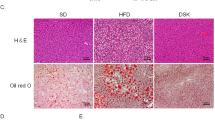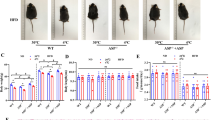Abstract
Background/objectives
The browning of white adipose tissue (WAT) has been in the spotlight during the last years, becoming an attractive approach to combat obesity. Melanocortin neuropeptides, such as α-melanocyte-stimulating hormone (α-MSH), are well-known regulators of appetite at the central nervous system, but its role in adipocyte metabolism is poorly elucidated. This study sought to verify if α-MSH can induce transdifferentiation of white to brown/beige adipocytes and to determine whether it can ameliorate the obesity phenotype.
Methods
The browning effect of α-MSH was determined in isolated adipocytes using the 3T3-L1 cell line and in inguinal subcutaneous adipose tissue (ingWAT) of diet-induced obese (DIO) mice by quantifying the expression of browning hallmark genes, oxygen consumption, and mitochondrial biogenesis. α-MSH protection from diet-induced obesity was evaluated by analyzing mice body weight, fat mass, and lipid and glucose serum profiles.
Results
Here, we report that α-MSH activates a thermogenic gene program and increases the mitochondrial respiratory rate in 3T3-L1 adipocytes and ingWAT of DIO mice. Without affecting food intake, peripheral administration of α-MSH decreases body weight and ingWAT mass, promoting a significant rise in the number of smaller adipocytes, whereas it lowered the larger ones. Additionally, there was an increase in the mass of brown adipose tissue. Browning activation occurs concomitantly with improvement on serum lipid profile, insulin resistance, and glucose homeostasis.
Conclusions
This study highlights the anti-obesity properties of melanocortins by promoting ingWAT browning and provides new perspectives for future designing of more effective therapeutic strategies.
This is a preview of subscription content, access via your institution
Access options
Subscribe to this journal
Receive 12 print issues and online access
$259.00 per year
only $21.58 per issue
Buy this article
- Purchase on Springer Link
- Instant access to full article PDF
Prices may be subject to local taxes which are calculated during checkout





Similar content being viewed by others
References
Cinti S. Transdifferentiation properties of adipocytes in the adipose organ. Am J Physiol Endocrinol Metab. 2009;297:E977–86.
Kim SH, Plutzky J. Brown fat and browning for the treatment of obesity and related metabolic disorders. Diabetes Metab J. 2016;40:12–21.
Wu J, Cohen P, Spiegelman BM. Adaptive thermogenesis in adipocytes: is beige the new brown? Genes Dev. 2013;27:234–50.
Wang W, Seale P. Control of brown and beige fat development. Nat Rev Mol Cell Biol. 2016;17:691–702.
Seale P, Conroe HM, Estall J, Kajimura S, Frontini A, Ishibashi J, et al. Prdm16 determines the thermogenic program of subcutaneous white adipose tissue in mice. J Clin Invest. 2011;121:96–105.
Han Y, Wu JZ, Shen JZ, Chen L, He T, Jin MW, et al. Pentamethylquercetin induces adipose browning and exerts beneficial effects in 3T3-L1 adipocytes and high-fat diet-fed mice. Sci Rep. 2017;7:1123.
Michael NJ, Simonds SE, van den Top M, Cowley MA, Spanswick D. Mitochondrial uncoupling in the melanocortin system differentially regulates NPY and POMC neurons to promote weight-loss. Mol Metab. 2017;6:1103–12.
Dodd GT, Decherf S, Loh K, Simonds SE, Wiede F, Balland E, et al. Leptin and insulin act on POMC neurons to promote the browning of white fat. Cell. 2015;160:88–104.
Rodrigues AR, Almeida H, Gouveia AM. Alpha-MSH signalling via melanocortin 5 receptor promotes lipolysis and impairs re-esterification in adipocytes. Biochim Biophys Acta. 2013;1831:1267–75.
Møller CL, Raun K, Jacobsen ML, Pedersen T, Holst B, Conde-Frieboes KW, et al. Characterization of murine melanocortin receptors mediating adipocyte lipolysis and examination of signalling pathways involved. Mol Cell Endocrinol. 2011;341:9–17.
Kooijman S, Boon MR, Parlevliet ET, Geerling JJ, van de Pol V, Romijn JA, et al. Inhibition of the central melanocortin system decreases brown adipose tissue activity. J Lipid Res. 2014;55:2022–32.
Brito MN, Brito NA, Baro DJ, Song CK, Bartness TJ. Differential activation of the sympathetic innervation of adipose tissues by melanocortin receptor stimulation. Endocrinology. 2007;148:5339–47.
Voss-Andreae A, Murphy JG, Ellacott KL, Stuart RC, Nillni EA, Cone RD, et al. Role of the central melanocortin circuitry in adaptive thermogenesis of brown adipose tissue. Endocrinology. 2007;148:1550–60.
Yasuda T, Masaki T, Kakuma T, Yoshimatsu H. Hypothalamic melanocortin system regulates sympathetic nerve activity in brown adipose tissue. Exp Biol Med. 2004;229:235–9.
Williams DL, Bowers RR, Bartness TJ, Kaplan JM, Grill HJ. Brainstem melanocortin 3/4 receptor stimulation increases uncoupling protein gene expression in brown fat. Endocrinology. 2003;144:4692–7.
Biswas HM. Effect of adrenocorticotropic hormone on UCP1 gene expression in brown adipocytes. J Basic Clin Physiol Pharmacol. 2017;28:267–74.
Iwen KA, Senyaman O, Schwartz A, Drenckhan M, Meier B, Hadaschik D, et al. Melanocortin crosstalk with adipose functions: ACTH directly induces insulin resistance, promotes a pro-inflammatory adipokine profile and stimulates UCP-1 in adipocytes. J Endocrinol. 2008;196:465–72.
Forbes S, Bui S, Robinson BR, Hochgeschwender U, Brennan MB. Integrated control of appetite and fat metabolism by the leptin-proopiomelanocortin pathway. Proc Natl Acad Sci USA. 2001;98:4233–7.
Rodrigues AR, Almeida H, Gouveia AM. Melanocortin 5 receptor signaling and internalization: role of MAPK/ERK pathway and β-arrestins 1/2. Mol Cell Endocrinol. 2012;361:69–79.
Ukropec J, Anunciado RP, Ravussin Y, Hulver MW, Kozak LP. UCP1-independent thermogenesis in white adipose tissue of cold-acclimated Ucp1(-/-) mice. J Biol Chem. 2006;281:31894–908.
Kraunsoe R, Boushel R, Hansen CN, Schjerling P, Qvortrup K, Stockel M, et al. Mitochondrial respiration in subcutaneous and visceral adipose tissue from patients with morbid obesity. J Physiol. 2010;588(Pt 12):2023–32.
Dechandt CRP, Couto-Lima CA, Alberici LC. Triglyceride depletion of brown adipose tissue enables analysis of mitochondrial respiratory function in permeabilized biopsies. Anal Biochem. 2016;515:55–60.
Lee YS, Kim JW, Osborne O, Oh DY, Sasik R, Schenk S, et al. Increased adipocyte O2 consumption triggers HIF-1alpha, causing inflammation and insulin resistance in obesity. Cell. 2014;157:1339–52.
Garcia Fernandez MI, Ceccarelli D, Muscatello U. Use of the fluorescent dye 10-N-nonyl acridine orange in quantitative and location assays of cardiolipin: a study on different experimental models. Anal Biochem. 2004;328:174–80.
Rosell M, Kaforou M, Frontini A, Okolo A, Chan YW, Nikolopoulou E, et al. Brown and white adipose tissues: intrinsic differences in gene expression and response to cold exposure in mice. Am J Physiol Endocrinol Metab. 2014;306:E945–64.
de Jong JM, Larsson O, Cannon B, Nedergaard J. A stringent validation of mouse adipose tissue identity markers. Am J Physiol Endocrinol Metab. 2015;308:E1085–105.
Sharp LZ, Shinoda K, Ohno H, Scheel DW, Tomoda E, Ruiz L, et al. Human BAT possesses molecular signatures that resemble beige/brite cells. PLoS ONE. 2012;7:e49452.
Wu J, Bostrom P, Sparks LM, Ye L, Choi JH, Giang AH, et al. Beige adipocytes are a distinct type of thermogenic fat cell in mouse and human. Cell. 2012;150:366–76.
Kahn BB, Flier JS. Obesity and insulin resistance. J Clin Invest. 2000;106:473–81.
Shepherd PR, Gnudi L, Tozzo E, Yang H, Leach F, Kahn BB. Adipose cell hyperplasia and enhanced glucose disposal in transgenic mice overexpressing GLUT4 selectively in adipose tissue. J Biol Chem. 1993;268:22243–6.
Minokoshi Y, Kahn CR, Kahn BB. Tissue-specific ablation of the GLUT4 glucose transporter or the insulin receptor challenges assumptions about insulin action and glucose homeostasis. J Biol Chem. 2003;278:33609–12.
Abdullahi A, Jeschke MG. Taming the flames: targeting white adipose tissue browning in hypermetabolic conditions. Endocr Rev. 2017;38:538–49.
Garcia RA, Roemmich JN, Claycombe KJ. Evaluation of markers of beige adipocytes in white adipose tissue of the mouse. Nutr Metab. 2016;13:24.
Wang H, Liu L, Lin JZ, Aprahamian TR, Farmer SR. Browning of white adipose tissue with roscovitine induces a distinct population of UCP1(+) adipocytes. Cell Metab. 2016;24:835–47.
Ferrannini G, Namwanje M, Fang B, Damle M, Li D, Liu Q, et al. Genetic backgrounds determine brown remodeling of white fat in rodents. Mol Metab. 2016;5:948–58.
Shabalina IG, Petrovic N, de Jong JM, Kalinovich AV, Cannon B, Nedergaard J. UCP1 in brite/beige adipose tissue mitochondria is functionally thermogenic. Cell Rep. 2013;5:1196–203.
Kazak L, Chouchani ET, Jedrychowski MP, Erickson BK, Shinoda K, Cohen P, et al. A creatine-driven substrate cycle enhances energy expenditure and thermogenesis in beige fat. Cell. 2015;163:643–55.
Ikeda K, Kang Q, Yoneshiro T, Camporez JP, Maki H, Homma M, et al. UCP1-independent signaling involving SERCA2b-mediated calcium cycling regulates beige fat thermogenesis and systemic glucose homeostasis. Nat Med. 2017;23:1454–65.
Pierroz DD, Ziotopoulou M, Ungsunan L, Moschos S, Flier JS, Mantzoros CS. Effects of acute and chronic administration of the melanocortin agonist MTII in mice with diet-induced obesity. Diabetes. 2002;51:1337–45.
Mountjoy KG,Wong J, Obesity, diabetes and functions for proopiomelanocortin-derived peptides. Mol Cell Endocrinol. 1997;128:171–7.
Boston BA, Cone RD. Characterization of melanocortin receptor subtype expression in murine adipose tissues and in the 3T3-L1 cell line. Endocrinology. 1996;137:2043–50.
Gan L, Liu Z, Chen Y, Dan L, Feng F, Liu G, et al. alpha-MSH and Foxc2 promote fatty acid oxidation through C/EBPbeta negative transcription in mice adipose tissue. Sci Rep. 2016;6:36661.
Rodrigues AR, Almeida H, Gouveia AM. Intracellular signaling mechanisms of the melanocortin receptors: current state of the art. Cell Mol Life Sci. 2015;72:1331–45.
Enriori PJ, Chen W, Garcia-Rudaz MC, Grayson BE, Evans AE, Comstock SM, et al. α-Melanocyte stimulating hormone promotes muscle glucose uptake via melanocortin 5 receptors. Mol Metab. 2016;5:807–22.
Møller CL, Kjøbsted R, Enriori PJ, Jensen TE, Garcia-Rudaz C, Litwak SA, et al. α-MSH stimulates glucose uptake in mouse muscle and phosphorylates Rab-GTPase-activating protein TBC1D1 independently of AMPK. PLoS ONE. 2016;11:e0157027.
Atkinson BJ, Griesel BA, King CD, Josey MA, Olson AL. Moderate GLUT4 overexpression improves insulin sensitivity and fasting triglyceridemia in high-fat diet-fed transgenic mice. Diabetes. 2013;62:2249–58.
Kusminski CM, Bickel PE, Scherer PE. Targeting adipose tissue in the treatment of obesity-associated diabetes. Nat Rev Drug Discov. 2016;15:639–60.
Funding
This work was financially supported by FCT/MEC (PIDDAC) and FEDER–Fundo Europeu de Desenvolvimento Regional, COMPETE 2020–Programa Operacional Competitividade e Internacionalização (PTDC/BIM-MET/2123/2014) and Tanita Healthy Weight Community Trust. Parts of this work were supported by a grant from FCT to the Research Center in Physical Activity, Health and Leisure, UID/DTP/00617/2013 and PTDC/DTP-DES/7087/2014 - POCI-01-0145-FEDER-016690. ARR (SFRH/BPD/92868/2013) and SRR (SFRH/BD/89807/2012) are supported by FCT.
Author contributions
ARR and MJS performed the majority of the in vivo and in vitro experiments. SRR, IOG, and JM provided technical assistance in the oxygen consumption measurements. CC performed the subcutaneous implantation of osmotic mini-pumps in DIO mice. DN and HA contributed to experimental design and actively participated in the revision of the manuscript. ARR and AMG conceived the project, designed the experiments, analyzed the data, and wrote the manuscript with the input from the other authors.
Author information
Authors and Affiliations
Corresponding author
Ethics declarations
Conflict of interest
The authors declare that they have no conflict of interest.
Electronic supplementary material
Rights and permissions
About this article
Cite this article
Rodrigues, A.R., Salazar, M.J., Rocha-Rodrigues, S. et al. Peripherally administered melanocortins induce mice fat browning and prevent obesity. Int J Obes 43, 1058–1069 (2019). https://doi.org/10.1038/s41366-018-0155-5
Received:
Revised:
Accepted:
Published:
Issue Date:
DOI: https://doi.org/10.1038/s41366-018-0155-5



